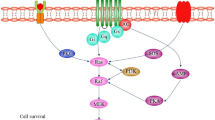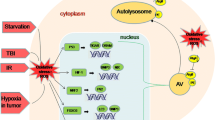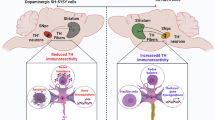Abstract
Excessive oxidative stress has been implicated in the induction of cell death in a variety of neurodegenerative diseases. In the present study, hydrogen peroxide (H2O2)-induced cell death in rat C6 glioma cells was used as a model system for studying the molecular events associated with oxidative stress-induced cell death in glial cells. We demonstrate that exposure of C6 glioma cells to H2O2 results in apoptotic cell death in a concentration-dependent manner, and caused activation of a member of the caspase-3-like family of proteases resulting in cleavage of the DNA repair enzyme poly(ADP-ribose)polymerase, PARP. Furthermore, H2O2 induced a transient activation of the transcription factor, nuclear factor kappa B (NFkB). Pre-treatment of cells with the antioxidant N-acetyl-cysteine, (NAC), prevented both the activation of NFkB and the induction of apoptosis by H2O2, suggesting a possible role for this transcription factor in oxidant-induced apoptosis in glial cells. Exposure of the cells to H2O2 led to transient activation of both c-JunN-terminal kinase (JNK) and p38 kinase but has no effect on extracellular regulated kinase (ERK) activity. Inhibition of p38 by SB203580 did not protect the cells against H2O2-induced apoptosis suggesting that activation of p38 is not essential for H2O2-mediated cell death in C6 glioma cells.
Similar content being viewed by others
References
Anderson, P. (1997) Kinase cascades regulating entry into apoptosis.Microbiol. Mol. Biol. Rev. 61, 33–46.
Baeuerle, P.A., Henkel, T. (1994) Function and activation of NFkB in the immune system.Annu Rev Immunol 12, 141–179.
Barinaga, M. (1998a) Is apoptosis key in alzheimer’s disease?Science 281, 1303–1304.
Barinaga, M. (1998b) Stroke-damaged neurons may commit cellular suicide.Science 281, 1302–1303.
Beg, A.A. and Baltimore, D. (1996) An essential role for NFkB in preventing TNF-alpha-induced cell death.Science 274, 782–784.
Bhat, R.B. and Zhang, P. (1999) Hydrogen peroxide activation of multiple mitogen-activated protein kinases in an oligodendrocyte cell line: role of extracellular signal-regulated kinase in hydrogen peroxide-induced cell death.J. Neurochem. 72, 112–119.
Boland, M.P., Foster, S.J. and O’Neill, L.A.J. (1997) Daunoru-bicin activates NFkB and induce KB-dependent gene expression in HL-60 promyelocytic and Jurkat T lymphoma cells.J. Biol. Chem. 272, 12952–12960.
Bradford, M.M. (1976) A rapid and sensitive method for the quantitation of microgram quantities of protein using the principal of protein-dye binding.Anal. Biochem. 73, 248–254.
Casano, F.J., Rolando, A.M., Mudgett, J.S. and Molineaux, S.M. (1994) The structure and complete nucleotide sequence of the murine gene encoding interleukin-1β converting enzyme (ICE).Genomics 20, 474–481.
Chu, Z.L., McKinsey, T.A., Liu, L., Gentry, J.J., Malim, M.H. and Ballard, D.W. (1997) Suppression of tumour necrosis factor-induced cell death by inhibitor of apoptosis c-IAP-2 is under NFkappaB control.Proc. Natl. Acad. Sci. U.S.A. 94, 10057–10063.
Cohen, G.M. (1997) Caspases: the executioners of apoptosis.Biochem. J. 326, 1–16.
Cowden, R.R. and Curtis, S.K. (1981) Microfluorimetric investigations of chromatin structure.Histochemistry 72, 11–23.
Gardner, A.M. and Johnson, G.L. (1996) Fibroblast growth factor-2 suppression of tumor necrosis factor-mediated apoptosis requires ras and the activation of mitogen-activated protein kinase.J. Biol. Chem. 271, 14560–14566.
Giri, D.K. and Aggarwal, B.B. (1998) Constitutive activation of NFkB causes resistance to apoptosis in human cancerous T cell lymphoma HuT 78 cells.J. Biol. Chem. 273, 14008–14014.
Gupta, S., Campbell, D., Derijard, B. and Davis, R.J. (1995) Transcription factor ATF2 regulation by the JNK signal transduction pathway.Science 267, 389–393.
Gwag, B.J., Lobner, D., Koh, J. and Choi, D.W. (1994) Blockade of glutamate receptors during oxygen or glucose deprivation unmasks apoptosis in cultured cortical neurons.Neurosci. Abs. 15, 248.
Hampton, M.B. and Orrenius, S. (1997) Dual regulation of caspase activity by hydrogen peroxide: implication for apoptosis.FEBS lett. 414, 552–556.
Janicke, R.U., Ng, P., Sprengart, ML., Porter, A.G. (1998) Caspase-3 is required for alpha-fodrin cleavage but dispensable for cleavage of other death substrates in apoptosis.J. Biol. Chem. 273, 15540–15545.
Kitamura, Y., Ota, T., Matsuoka, Y., Tooyama, I., Kimura, H., Shimohama, S., Nomura, Y., Gebicke-Haerter, P.J. and Taniguchi, T. (1999) Hydrogen peroxide-induced apoptosis mediated by p53 protein in glial cells.Glia 25, 154–164.
Liu, X.Z., Xu, X.M., Hu, R., Du, C, Zhang, S.X., McDonald, J.W., Dong, H.X., Wu, Y.J., Fan, G.S., Jacquin, M.F., Hsu, C.Y., Choi, D.W. (1997) Neuronal and glial apoptosis after traumatic spinal cord injury.J. Neurosci. 17, 5395–5406.
Lassman, H., Bancher, C, Breitschopf, H., Wiegel, J., Bobin-ski, M., Jellinger, K. and Wisniewski, H.M. (1995) Cell death in Alzheimer’s disease evaluated by DNA fragmentation in situ.Acta. Neuropathol. 89, 35–41.
Martin, S.J., Newmeyer, D.D., Mathias, S., Farschon, D.M., Wang, H., Reed, J.C. and Green, D.R. (1995) Cell free reconstitution of Fas-, UV radiation- and cera-mide-induced apoptosis.EMBO J. 14, 5191–5200.
Meyer, M., Pahl, H.L. and Baeuerle, P.A. (1994) Regulation of the transcription factors NF-kappa B and AP-1 by redox changes.Chem. Biol. Interact. 91, 91–100.
Mosieniak, G., Figiel, I. and Kaminska, B. (1997) Cyclosporin A, an immunosuppressive drug induces programmed cell death in rat C6 glioma cells by a mechanism that involves the AP-1 transcription factor.J. Neurochem. 68, 1142–1149.
Moynagh, P.N., Williams, D.C. and O’Neill, L.A.J. (1993) Interleukin-1 activates transcription factor NF-kappa-B in glial cells.Biochem. J. 294, 343–347.
O’Connell, M.A., Cleere, R., Long, A., O’Neill, L.A.J and Kel-leher D. (1995) Cellular proliferation and activation of NF-kappa B are induced by autocrine production of tumour necrosis factor alpha in the human T lymphoma line HuT 78.J. Biol. Chem. 270, 7399–7404.
O’Neill, L.A.J and Kaltschmidt, C. (1997) NFkB: a crucial transcription factor for glial and neuronal cell function. Trends Neuro Sci20: 252–258.
Ozaki, I., Tani, E., Ikemoto, H., Kitagawa, H. and Fujikawa, H. (1999) Activation of stress-activated protein kinase/c-Jun NH2-terminal kinase and p38 kinase in cal-phostin C-induced apoptosis requires caspase-3-like proteases but is indispensable for cell death. J. Biol. Chem.274, 5310–5217.
Polverino, A.J. and Patterson, S.D. (1997) Selective activation of caspases during apoptotic induction of HL-60 cells.J. Biol. Chem. 272, 7013–7021.
Robinson, M.J. and Cobb, M.H. (1997) Mitogen-activated protein kinase pathways.Curr. Opin. Cell Biol. 9, 180186.
Schulze-Osthoff, K., Krammer, P.H. and Droge W. (1994) Divergent signalling via APO-1/Fas and the TNF recepor, two homologous molecules involved in physiological cell death.EMBO J. 13, 4587–4596.
Schraufstatter, I.U., Hyslop, P.A., Hinshaw, D.B., Spragg, R.G., Sklar, L..A and Cochrane, C.G. (1986) Hydrogen peroxide induced injury of cells and its prevention by inhibitors of poly(ADP-ribose)polymerase.Proc. Natl. Acad. Sci. USA. 83, 4908–4912.
Siman, R., Bozyczko-Coyne, D., Meyer, S.L. and Bhat RV. (1999) Immunolocalization of caspase proteolysis in situ: evidence for widespread caspase-mediated apoptosis of neurons and glia in the postnatal rat brain.Neuroscience 92, 1425–1442.
Simonian, N.A., Coyle, J.T. (1996) Oxidative stress in neurodegenerative diseases. Annu. Rev. Pharmacol. Toxicol.36, 83–106.
Smale G., Nichols NR, Brady DR, Finch CE, Horton WE. (1995) Evidence for apoptotic cell death in Alzheimer’s disease.Exp. Neurol. 133, 225–230.
Stridh, H., Kimland, M., Jones, D.P., Orrenius, S., Hampton, M.B. (1998) Cytochrome C release and caspase activation in hydrogen peroxide- and tributyltin-induced apoptosisFEBS lett. 429, 351–355.
Thomas, E.L., Grisham, M.B., Melton, D.F. and Jefferson, M.M. (1985) Evidence for a role of taurine in the in vitro oxidative toxicity of neutrophils towards erythrocytes.J. Biol. Chem. 260, 3321–3329.
Thornberry, N.A., Rano, T.A., Peterson, E.P., Rasper, D.M., Timkey, T., Garcia-Calvo, M., Houtzager, V.M., Nord-strum, P.A., Roy, S., Vaillancourt, J.P., Chapman, K.T. and Nicholson, D.W. (1997) A combinatorial approach defines specificities of members of the caspase family and granzyme B.J. Biol. Chem. 272, 17907–17911.
Whittemore, E.R., Loo, D.T., Cotman C.W. (1994) Exposure to hydrogen peroxide induces cell death via apoptosis in cultured rat cortical neurons.Neuroreport 5, 1485–1488.
Wu, M. and Lozano, G. (1994) NFkB activation of p53. A potential mechanism for suppressing cell growth in response to stress.J. Biol. Chem. 269, 20067–20074.
Wylie, A.H., Kerr, J. FR. and Currie, A.R. (1980) Cell death: the significance of apoptosis.Int. Rev. Cytol. 68, 251–306.
Xiang, J., Chao, D.T. and Korsmeyer, S.J. (1996) Bax-induced cell death may not require interleukin-1-converting enzyme-like proteases.Proc. Natl. Acad. Sci. U.S.A. 93, 14559–14563.
Yasugi, E., Nakata, K., Yokoyama, Y., Kano, K., Dohi, T. and Oshima, M. (1998) Dihydroheptoprenyl and dihydro-decprenyl monophosphate induce apoptosis mediated by activation of caspase-3-like protease.Biochim. Biophys. Acta. 1389, 132–140.
Yoshimura, S-I., Sakai, H., Ohguchi, K., Nakashima, S., Banno, Y., Nishimura, Y., Sakai, N., Nozawa, Y. (1997) Changes in the activity and mRNA levels of phospholi-pase D during ceramide-induced apoptosis in rat C6 glial cells.J. Neurochem. 69, 713–720.
Zisterer, D.M., Hance, H., Campiani, G., Garofalo, A., Nacci, V. and Williams, D.C. (1998) Antiproliferative action of pyrrolobenzoxazepine derivatives in cultured cells.Biochem. Pharmacol. 55, 397–403.
Author information
Authors and Affiliations
Corresponding author
Rights and permissions
About this article
Cite this article
Marangolo, M., McGee, M.M., Tipton, K.F. et al. Oxidative stress induces apoptosis in C6 glioma cells: Involvement of mitogen-activated protein kinases and nuclear factor kappa B. neurotox res 3, 397–409 (2001). https://doi.org/10.1007/BF03033200
Received:
Revised:
Issue Date:
DOI: https://doi.org/10.1007/BF03033200




